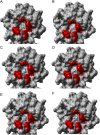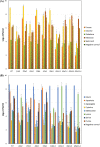Diverse Sensory Repertoire of Paralogous Chemoreceptors Tlp2, Tlp3, and Tlp4 in Campylobacter jejuni
- PMID: 36374080
- PMCID: PMC9769880
- DOI: 10.1128/spectrum.03646-22
Diverse Sensory Repertoire of Paralogous Chemoreceptors Tlp2, Tlp3, and Tlp4 in Campylobacter jejuni
Abstract
Campylobacter jejuni responds to extracellular stimuli via transducer-like chemoreceptors (Tlps). Here, we describe receptor-ligand interactions of a unique paralogue family of dCache_1 (double
Keywords: Campylobacter jejuni; chemoreceptor; chemotaxis; ligand discovery.
Conflict of interest statement
The authors declare no conflict of interest.
Figures







Similar articles
-
The dCache Domain of the Chemoreceptor Tlp1 in Campylobacter jejuni Binds and Triggers Chemotaxis toward Formate.mBio. 2023 Jun 27;14(3):e0356422. doi: 10.1128/mbio.03564-22. Epub 2023 Apr 13. mBio. 2023. PMID: 37052512 Free PMC article.
-
Characterisation of a multi-ligand binding chemoreceptor CcmL (Tlp3) of Campylobacter jejuni.PLoS Pathog. 2014 Jan;10(1):e1003822. doi: 10.1371/journal.ppat.1003822. Epub 2014 Jan 2. PLoS Pathog. 2014. PMID: 24391495 Free PMC article.
-
Structure-Activity Relationship Study Reveals the Molecular Basis for Specific Sensing of Hydrophobic Amino Acids by the Campylobacter jejuni Chemoreceptor Tlp3.Biomolecules. 2020 May 11;10(5):744. doi: 10.3390/biom10050744. Biomolecules. 2020. PMID: 32403336 Free PMC article.
-
Campylobacter jejuni transducer like proteins: Chemotaxis and beyond.Gut Microbes. 2017 Jul 4;8(4):323-334. doi: 10.1080/19490976.2017.1279380. Epub 2017 Jan 12. Gut Microbes. 2017. PMID: 28080213 Free PMC article. Review.
-
Aspartate chemosensory receptor signalling in Campylobacter jejuni.Virulence. 2010 Sep-Oct;1(5):414-7. doi: 10.4161/viru.1.5.12735. Virulence. 2010. PMID: 21178481 Review.
Cited by
-
Sensing preferences for prokaryotic solute binding protein families.Microb Biotechnol. 2023 Sep;16(9):1823-1833. doi: 10.1111/1751-7915.14292. Epub 2023 Aug 7. Microb Biotechnol. 2023. PMID: 37547952 Free PMC article.
-
Bacterial sensor evolved by decreasing complexity.Proc Natl Acad Sci U S A. 2025 Feb 4;122(5):e2409881122. doi: 10.1073/pnas.2409881122. Epub 2025 Jan 29. Proc Natl Acad Sci U S A. 2025. PMID: 39879239 Free PMC article.
-
The dCache Domain of the Chemoreceptor Tlp1 in Campylobacter jejuni Binds and Triggers Chemotaxis toward Formate.mBio. 2023 Jun 27;14(3):e0356422. doi: 10.1128/mbio.03564-22. Epub 2023 Apr 13. mBio. 2023. PMID: 37052512 Free PMC article.
-
Campylobacter jejuni virulence factors: update on emerging issues and trends.J Biomed Sci. 2024 May 1;31(1):45. doi: 10.1186/s12929-024-01033-6. J Biomed Sci. 2024. PMID: 38693534 Free PMC article. Review.
-
Identification of a dCache-type chemoreceptor in Campylobacter jejuni that specifically mediates chemotaxis towards methyl pyruvate.Front Microbiol. 2024 May 9;15:1400284. doi: 10.3389/fmicb.2024.1400284. eCollection 2024. Front Microbiol. 2024. PMID: 38784811 Free PMC article.
References
Publication types
MeSH terms
Substances
Grants and funding
LinkOut - more resources
Full Text Sources
Molecular Biology Databases

